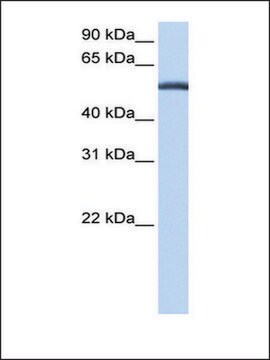CMC0014
BL21(DE3) Chemically Competent Cells
Escherichia coli, rod shaped
Synonyme(s) :
Competent E. coli cells
Se connecterpour consulter vos tarifs contractuels et ceux de votre entreprise/organisme
About This Item
Code UNSPSC :
41106202
Nomenclature NACRES :
NA.85
Produits recommandés
Nom du produit
BL21(DE3) Chemically Competent Cells, for protein expression
Source biologique
Escherichia coli
Qualité
Molecular Biology
Mode de croissance
adherent or suspension
Morphologie
rod shaped
Technique(s)
microbiological culture: suitable
Transformation cellulaire
competent cell type: chemically competent
transformation efficiency: ≥1 x 107 cfu/μg
Conditions d'expédition
dry ice
Température de stockage
−70°C
Description générale
The BL21(DE3) Chemically Competent strains contain the phage T7 RNA polymerase gene linked to the IPTG-inducible promoter, for use with any expression plasmid containing the T7 promoter.
Genotype
F – ompT hsdSB (rB- mB-) gal dcm (DE3)
Genotype
F – ompT hsdSB (rB- mB-) gal dcm (DE3)
Application
The E. coli strain BL21 (DE3) has been used:
- to express tau 2N4R isoform (aa1–441) and the truncated tau (aa1–421) using pET19b as expression vector.
- BL21(DE3)Chemically Competent Cells has been used for the transformation and expressionof protegrin-1 (PG1) peptides.
- to express 6His-TEVsite-Hs ARF1 (17-181)-Q71L in pHis2 vector.
Caractéristiques et avantages
- a transformation efficiency of >1 × 107 cfu/μg.
- economical prices
- offering superior value for everyday protein expression work.
Composants
- BL21(DE3) chemically competent cells
- pUC 19 transformation control DNA
- recovery medium for expression
Produit(s) apparenté(s)
Réf. du produit
Description
Tarif
Code de la classe de stockage
10 - Combustible liquids
Faites votre choix parmi les versions les plus récentes :
Déjà en possession de ce produit ?
Retrouvez la documentation relative aux produits que vous avez récemment achetés dans la Bibliothèque de documents.
Les clients ont également consulté
Yasaman Damestani et al.
Lasers in surgery and medicine, 48(8), 782-789 (2016-10-19)
The development and feasibility of a novel nanocrystalline yttria-stabilized-zirconia (nc-YSZ) cranial implant has been recently established. The purpose of what we now call "window to the brain (WttB)" implant (or platform), is to improve patient care by providing a technique
A validated antibody panel for the characterization of tau post-translational modifications.
Ebru E, et al.
Mol. Neurodegener., 12(1), 87-87 (2017)
Romana Koszagova et al.
Microbial cell factories, 17(1), 139-139 (2018-09-05)
Physiological aggregation of a recombinant enzyme into enzymatically active inclusion bodies could be an excellent strategy to obtain immobilized enzymes for industrial biotransformation processes. However, it is not convenient to recycle "gelatinous masses" of protein inclusion bodies from one reaction
David B Sauer et al.
eLife, 9 (2020-09-02)
Citrate, α-ketoglutarate and succinate are TCA cycle intermediates that also play essential roles in metabolic signaling and cellular regulation. These di- and tricarboxylates are imported into the cell by the divalent anion sodium symporter (DASS) family of plasma membrane transporters
Gints Kalnins et al.
Nature communications, 11(1), 388-388 (2020-01-22)
Bacterial microcompartments (BMCs) are prokaryotic organelles consisting of a protein shell and an encapsulated enzymatic core. BMCs are involved in several biochemical processes, such as choline, glycerol and ethanolamine degradation and carbon fixation. Since non-native enzymes can also be encapsulated
Notre équipe de scientifiques dispose d'une expérience dans tous les secteurs de la recherche, notamment en sciences de la vie, science des matériaux, synthèse chimique, chromatographie, analyse et dans de nombreux autres domaines..
Contacter notre Service technique





